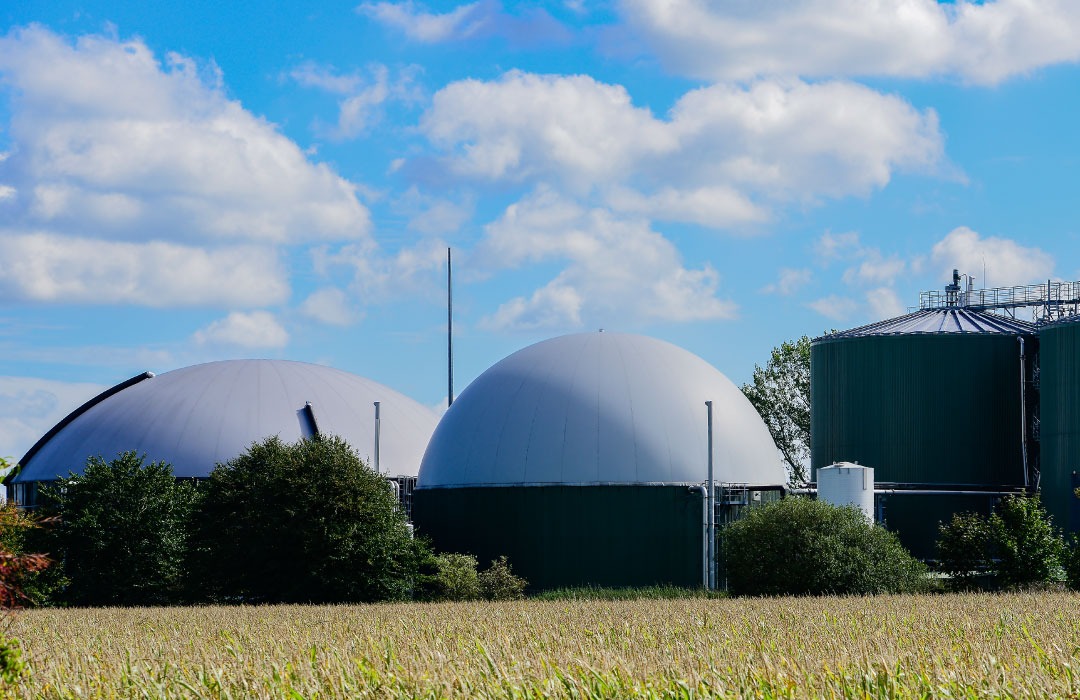What is anaerobic digestion technology?
Anaerobic digestion (AD) is a biological process that breaks down organic materials in the absence of oxygen. It produces biogas—a renewable energy source—and digestate, a nutrient-rich byproduct used in agriculture. AD is a cornerstone of sustainable waste management and energy generation.
Inputs and Outputs of the Process
Feedstocks include animal manure, food waste, crop residues, and sewage sludge. Outputs are biogas (used for electricity, heat, or fuel) and digestate (used as fertilizer).
How anaerobic digestion systems work?
AD systems optimize microbial activity across four biological stages: hydrolysis, acidogenesis, acetogenesis, and methanogenesis. Each stage involves distinct microbial communities that convert complex organic compounds into methane-rich biogas and nutrient-rich digestate. Modern AD systems are increasingly modular and tailored to specific feedstock profiles and operational goals.
Technologies include Continuous Stirred-Tank Reactors (CSTRs), Plug-Flow Digesters, Dry Fermentation Units, Covered Lagoons, Upgrading Units for biomethane purification, and Thermal Hydrolysis Pre-treatment to enhance gas yield. Advanced systems integrate IoT monitoring, AI-based feedstock optimization, and carbon capture technologies for real-time performance tracking and emissions reduction.
Key stages in the process
Feedstock preparation
Feedstock is sorted, shredded, and pre-treated to enhance digestion efficiency. Common materials include animal manure, food waste, crop residues, sewage sludge, and industrial byproducts. Blending feedstocks can stabilize digestion rates and improve gas yields.
Anaerobic fermentation
Microorganisms digest organic matter in sealed tanks under controlled temperature and pH conditions. The process is sensitive to feedstock composition, retention time, and microbial health.
Biogas capture and purification
Raw biogas typically contains methane (CH₄), carbon dioxide (CO₂), hydrogen sulfide (H₂S), and moisture. Purification systems remove impurities to produce high-quality biomethane. Technologies include pressure swing adsorption, membrane separation, and water scrubbing.
Energy conversion (electricity, heat, or vehicle fuel)
Purified biogas is converted into electricity via generators, used for heating, or compressed into CNG for vehicles. Some systems inject biomethane directly into natural gas pipelines.
Types of anaerobic digestion systems
Anaerobic digestion systems vary widely in design, scale, and operational mode. Choosing the right system depends on feedstock type, project goals, available space, and budget. Below are the main categories used to classify these systems.
Wet vs. dry systems
Wet systems process slurry-like feedstocks such as animal manure, sewage sludge, and food waste. They operate with high water content and are ideal for continuous flow systems. Dry systems handle solid organic waste like crop residues and food scraps, operating with lower moisture content and often used in batch mode.
Continuous vs. batch systems
Continuous systems receive feedstock regularly and produce biogas steadily, suitable for operations with consistent waste generation. Batch systems load feedstock all at once and digest over a set period, producing biogas in cycles and suitable for seasonal or pilot projects.
Small-scale vs. industrial-scale digesters
Small-scale digesters are used on farms or small communities, often employing plug-flow or covered lagoon designs. Industrial-scale digesters handle large volumes of waste and include advanced features like thermal hydrolysis, biogas upgrading, and carbon capture. These systems are used by municipalities and large agricultural enterprises.
Benefits of anaerobic digestion technology
Renewable energy generation
AD produces clean energy, reducing dependence on fossil fuels.
Waste reduction and circular economy
Organic waste is diverted from landfills and transformed into valuable resources.
Greenhouse gas emission reduction
Capturing methane prevents its release into the atmosphere, mitigating climate change.
From technology to implementation: The role of funding
Why financing is a key barrier for AD projects
High upfront costs for digesters and infrastructure often deter adoption, especially among small farms and municipalities.
How fundraising consulting services can help
Projects RH provides tailored fundraising consulting services that help clients overcome financial barriers. Their team prepares investor-ready materials including information memorandums, pitch decks, and teasers, ensuring projects are compelling and fundable.
Challenges and limitations
Technical barriers
Feedstock variability and system complexity can hinder performance.
Regulatory and policy issues
Permitting and compliance requirements vary across regions.
Financial constraints
Capital intensity and long payback periods require innovative financing models.
The future of anaerobic digestion and global energy goals
Innovations in system design
IoT monitoring, AI-based feedstock optimization, and carbon capture integration are reshaping AD systems.
Integration with other renewable energy sources
AD complements solar and wind by providing baseload energy and grid stability.
Global market outlook
Driven by climate targets and incentives, AD is expanding in agriculture, waste management, and energy sectors.
How to secure funding for your anaerobic digestion project?
Partnering with fundraising consulting experts
Projects RH helps clients secure funding by preparing strategic documentation and facilitating investor engagement. Their process includes:
– Building a financial model
– Drafting an information memorandum
– Summarizing into a pitch deck
– Creating a one-page teaser
– Supporting investor meetings and negotiations
Case Study: Urbenex BioEnergy and Projects RH
Urbenex BioEnergy deploys anaerobic digesters on dairy farms and landfills without requiring capital investment from hosts. They manage construction, operation, and maintenance, converting methane into CNG and repurposing digestate as fertilizer. Farmers earn annual bonuses of ~$200,000 for manure supply, turning waste into income.
Projects RH supports Urbenex by preparing information memorandums, pitch decks, and teasers that align with investor expectations. Their consulting ensures the project is investor-ready, addressing key questions and demonstrating financial viability. This partnership exemplifies how environmental stewardship and economic opportunity can coexist—delivering value to farmers, investors, and the planet.




